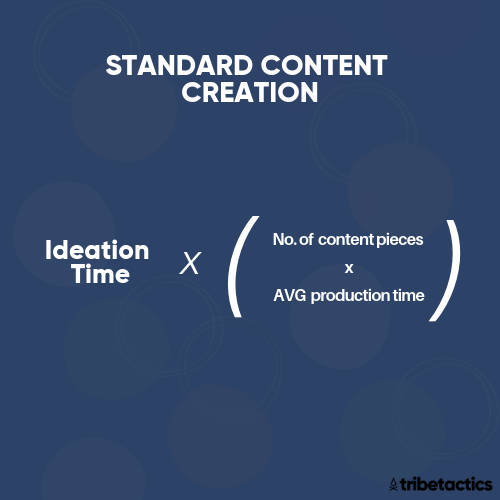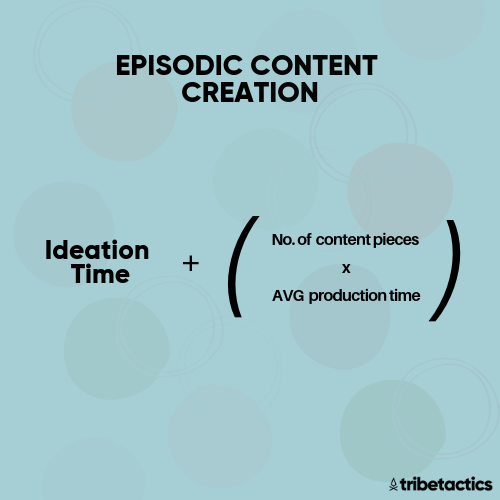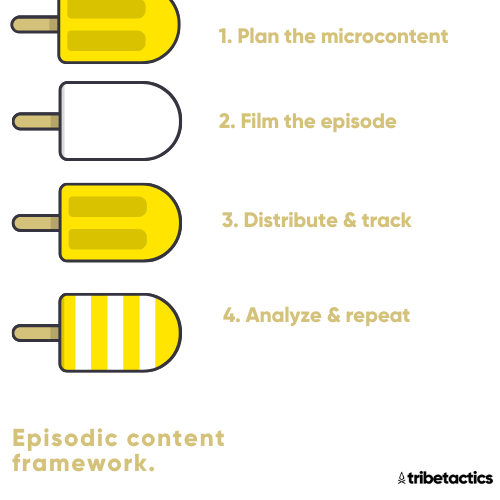Saving time on content creation by creating episodic content
Content marketing is essential, but often causes employee burn out due to the volume of things that needs to be done. Check out this guide on how creating episodic content drives more effectiveness, alignment, and efficiency within a marketing department..
We've recently taken the little-done philosophy of creating shows instead of ad-hoc content on the road, to both share with companies as well as learn more about how content is currently being done in-house.
The overall impression I got from each marketing team, no matter how big or small was:
There's never enough hours in the day; always playing catch up with the content they need to produce.
I couldn't help but relate, since I was in that same world as a marketer.
To add to the pressure, it's not enough to just be blogging. Content these days must come in different flavours.
In an effort to keep up with the content joneses, companies are under pressure to create more than just blogs and the occasional video every quarter.
If you run a marketing team, or are part of one, you may relate. Your marketing team has targets to hit depending on the stage of funnel they're focused on.
If its top of the funnel, it's things like social engagement, traffic, and lead gen. If it's further down, it's nurturing those leads, scoring them, and generating enough MQLs for Sales.
We're not just competing for mindshare from just competitors anymore. Everyone and their mom are on social and putting out, honestly, pretty good content.
Marketing directors and VPs of content need to start thinking outside the box, for real this time.
They need to do so in order to gain mind share quicker and in a scalable fashion that keeps costs within budget, while optimizing for maximum return to clearly show Marketing's dollar value in the organization.
Now on the one hand, it is important to be creating omnichannel marketing so that you're everywhere your core audience seeks you, but in the same time it's a mammoth of a task to do week in and week out.
It all comes down to the simple reason that content has to be inspired. You know good and well that not anything created can be shipped. It has to be considered with the persona in mind, has to be resonant with your brand values, etc.
Forcing good ideas
Inevitably what happens is your marketing team now has to go through this forced ideation process not just for every channel, but for every single content piece in every channel.
This leads to the marketer burnout that we've heard about from several companies.
As a result, content is either quality and delayed, or on-time but not up to par - both of which are pretty expensive for anyone in a crowded market place.
You're dealing with experts out there
I like to regard people as content "experts" in what they want to hear about - given our decades (yes, literally) of experience viewing and surveying all sorts of content out there. While they may not always know what they want since that's your job as a producer (faster horse), you best bet they would tell if something is done well or flaky.
Besides being expensive, it's also insanely difficult and expensive to do if you do not have a framework.
After spending years in the trenches myself across various corporations, I believe there is an easier way to go about this.
Enter episodic content.
Episodic content is creating content like you were putting together a new Netflix series. It is sequential, engaging video (and social) content that is part of a series centred around a certain theme or topic.
It helps brands shorten sales cycles, build visibility, and stay resource-effective.
Across the brands that we work with, we found it to more efficient, more impactful - and frankly - more fun. To think of your strategy as one of creating shows, not one of creating fragmented content assets, changes the game completely.
One of the core benefits of creating episodic content, is the ability to take each video pillar "episode" and efficiently repurpose that into multiple other content pieces, across audio, written, image, and even more microcontent subtitled videos.
In this article we'll focus on the time saving benefits of episodic content, applying some simple math.
The Math
If for every piece of content, lets say you need to add on average 1 hour of ideation and research, you will end up with a formula like this:

Put simply, the time it takes to strategize multiplied by the number of content pieces intended to create, multiplied by the average production time it takes to produce said content pieces.
Now when creating episodic content, you only need to ideate once to create the pillar piece, and from there, the total content pieces originate naturally.

Applying some numbers:
Normal content: 2 hours x 10 x 2 hours = 40 hours
Episodic content: 2 hours + (10 x 2 hours) = 22 hours
That's an 18 hour reduction to get the same amount of content, virtually speaking.
More likely, using the episodic content model will allow you to create a lot more content than what you're used to, which helps to keep your brand top of mind and also ensure that you're pumping out enough content, so we can adjust the number of content accordingly.
Episodic content: 2 hours + (20 x 2 hours) = 42 hours
For about the same time as creating content, in the above hypothetical example, you would be able to get double as much content.
While this is an oversimplified model, you get the idea.
The full episodic content framework then, would look something like this.

By thinking in terms of creating shows, you don't only set yourself apart in your industry, you also get more efficient because you only need to "think once".
Then once your pillar video episode is ready, you would be able to repurpose that to drive more focus on the topic, as well as communicate through various mediums and formats simultaneously.
Share this with your team if you feel like they're balancing too much at one time, or if the content efforts are producing too low an ROI for too high a resource cost.
P.S: Where we typically help customers is at the very start, with an episodic content strategy (ideation step), while simultaneously maximizing the number of content pieces produced and reducing the production time to a minimum.
Want to brainstorm more around this? Chat to us now or book a call below
